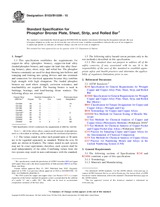We need your consent to use the individual data so that you can see information about your interests, among other things. Click "OK" to give your consent.
ASTM B103/B103M-15
Standard Specification for Phosphor Bronze Plate, Sheet, Strip, and Rolled Bar
STANDARD published on 15.5.2015
The information about the standard:
Designation standards: ASTM B103/B103M-15
Note: WITHDRAWN
Publication date standards: 15.5.2015
SKU: NS-609032
The number of pages: 7
Approximate weight : 21 g (0.05 lbs)
Country: American technical standard
Category: Technical standards ASTM
The category - similar standards:
Annotation of standard text ASTM B103/B103M-15 :
Keywords:
copper-tin alloy plate, copper-tin alloy rolled bar, copper-tin alloy sheet, copper-tin alloy strip, copper-tin-lead alloy plate, copper-tin-lead alloy rolled bar, copper-tin-lead alloy sheet, copper-tin-lead alloy strip, copper-tin-lead-zinc alloy plate, copper-tin-lead-zinc alloy rolled bar, copper-tin-lead-zinc alloy sheet, copper-tin-lead-zinc alloy strip, copper-tin-lead-zinc-iron alloy sheet, copper-tin-lead-zinc-iron alloy strip, UNS No. C51000, UNS No. C51100, UNS No. C51180
Additional information
| 1. Scope | |||||||||||||||||||||||||||||||||||||||||||||||||||||||||||||||||||
|
1.1 This specification establishes the requirements for copper-tin alloy (phosphor bronze), copper-tin-lead alloy (leaded phosphor bronze), and copper-tin-lead-zinc alloy (bearing bronze), plate, sheet, strip, and rolled bar. The phosphor bronzes commonly are used for deep drawing into bellows and stamping and forming into spring devices and into terminals and connectors for electrical apparatus because they combine high strength with high elongation. The leaded phosphor bronzes are used where strength, corrosion resistance, and machinability are required. The bearing bronze is used in bushings, bearings, and load-bearing thrust washers. The following alloys are covered:
Note 1: All of the above alloys contain small amounts of
phosphorus, used as a deoxidant in melting, and to enhance the
mechanical properties.
1.2 The values stated in either inch-pound units or SI units are to be regarded separately as standard. Within the text, SI units are shown in brackets. The values stated in each system may not be exact equivalents; therefore, each system shall be used independently of the other. Combining values from the two systems may result in non-conformance with the standard. 1.3 The following safety hazard caveat pertains only to the test method(s) described in this specification. 1.3.1 This standard does not purport to address all of the safety concerns, if any, associated with its use. It is the responsibility of the user of this standard to establish appropriate safety and health practices and determine the applicability of regulatory limitations prior to use. |
|||||||||||||||||||||||||||||||||||||||||||||||||||||||||||||||||||
| 2. Referenced Documents | |||||||||||||||||||||||||||||||||||||||||||||||||||||||||||||||||||
|
We recommend:
Technical standards updating
Do you want to make sure you use only the valid technical standards?
We can offer you a solution which will provide you a monthly overview concerning the updating of standards which you use.
Would you like to know more? Look at this page.




 Cookies
Cookies
